As artificial intelligence (AI) tools become more accessible, ubiquitous, and advanced, their applications have exploded across industries, from finance and healthcare, to entertainment and education. But while much of the AI conversation centers around productivity and the future of manual work, a more concerning trend is emerging: cybercriminals are now using AI to supercharge increasingly convincing and scalable scams.
AI-powered scams are also impacting the cryptocurrency industry, as many fraudsters are combining the pseudonymity of digital assets with the automation of AI to exploit users at scale. Unfortunately, these scams are often harder to detect, faster to deploy, and disturbingly convincing.
What Are AI-Powered Crypto Scams?
Unlike traditional crypto scams, typically manual and repetitive, AI-powered scams harness the speed, scale, and sophistication of modern machine learning (ML) models. They are therefore more adaptive, harder to spot, and often convincingly human.
At the intersection of AI and crypto lies a perfect storm: crypto is decentralized, fast-moving, and not consistently regulated across jurisdictions. AI adds another layer of deception by creating fake identities, realistic conversations, and websites nearly indistinguishable from the real versions.
Scammers are increasingly turning to AI because it offers scalability, believability, and automation. A single attacker can now deploy thousands of phishing messages, fake support agents, or investment bots: all generated and managed by AI.
The chart below shows the share of the total scam ecosystem made up of known counterparties to AI software vendors. The volume share shows the proportion of total scam inflows to scams that have also sent value to AI software vendors on-chain (representing a likely purchase of AI tools). The deposits share shows that roughly 60% of all deposits into scam wallets on-chain go into scams that leverage AI. Both statistics have been steadily increasing since 2021, around when AI started to reach the mainstream, and show that this ecosystem is increasingly dominated by AI-powered scams.
Common Types of AI-powered Crypto Scams
Here are some of the most common ways malicious actors are using AI in crypto:
Deepfake scams
: AI-generated videos or images depict trusted public figures, influencers, or executives promoting fraudulent crypto projects or giveaways.
AI-generated phishing
: Fraudsters craft sophisticated phishing emails, fake websites, and direct messages using AI to mimic natural language and personalize attacks based on a user’s online behavior.
Fake investment bots
: Scammers deploy AI trading bots that simulate successful trades or offer fake signals to lure users into depositing funds or following questionable financial advice.
KYC bypass
: Scammers use AI-generated images and/or credentials to bypass KYC controls and two-factor authentication (2FA).
Chatbot scams
: AI-powered bots infiltrate popular crypto communities on Discord and Telegram, and impersonate moderators or project administrators, tricking users into sharing wallet information or clicking malicious links.
AI customer support impersonation: Scammers use AI to mimic support agents from exchanges or wallet providers, often in real-time chats, to extract login credentials or recovery phrases.
AI-assisted pig butchering scams
: Scammers gain a victim’s trust — often over weeks or months — before convincing them to invest large sums into fake crypto platforms, with AI supporting communication and content generation.
Voice cloning and real-time scam calls
: AI replicates the voice of a known individual — such as a family member, colleague, or executive — to urgently request access to a user’s wallet or crypto exchange account.
The Anatomy of Modern AI Scams
Social Engineering at Scale
AI has democratized social engineering, allowing scammers to automate personalized manipulation. WhatsApp impersonation scams now target the platform's 2 billion users with fake exchange support groups and urgency-driven messages. These campaigns leverage AI-synthesized voices and cloned branding to harvest private keys or install remote-access malware. The 2025 JPEX case in Hong Kong exemplifies this trend, where influencers using manipulated social media content allegedly defrauded investors of $205 million through unlicensed trading platforms.
Adaptive Malware and Infrastructure Attacks
Google's Threat Intelligence Group has identified at least five novel malware strains using LLMs for real-time code generation, enabling them to morph continuously and avoid static analysis. This "polymorphic" approach allows attacks like the $1.46 billion Bybit breach to bypass traditional security layers . Meanwhile, AI-powered phishing kits automatically generate counterfeit exchange websites complete with fabricated user reviews and deepfake testimonials, eroding trust in legitimate platforms.
The AI Crime Epidemic: Scale and Sophistication
The evolution of AI-driven crypto crime represents a quantum leap from traditional scams. Criminals now employ generative adversarial networks (GANs) to create convincing deepfake videos, audio clones, and synthetic identities that bypass conventional verification systems. Recent reports indicate a 456% increase in AI-powered fraud since 2024, with deepfake technology becoming 550% more prevalent since 2019 . These tools enable attacks ranging from voice-cloned "emergency" calls from relatives to fabricated CEO endorsements for fraudulent investment platforms.
The damage extends beyond individual victims. North Korean hacking group UNC1069 has weaponized large language models like Google's Gemini to dynamically generate malicious code and phishing scripts that evade signature-based detection. Similarly, AI-driven "wrench attacks", physical coercion to extract private keys, have reached record levels as criminals identify high-value targets through social media tracking. The Central Bank of Ireland recently warned that deepfake scams have evolved from promising unrealistic returns to offering slightly above-market yields, making them increasingly difficult to detect.
As generative AI (GenAI) advances, bad actors are now able to deploy sophisticated chatbots, deepfake videos, cloned voices, and automated networks of scam tokens at a scale never seen before. As a result, crypto fraud is no longer a human-driven operation, but rather algorithmic, fast, adaptive, and increasingly convincing.
Technology alone cannot solve the AI fraud epidemic. Surveys indicate that 68% of investors now distrust unsolicited crypto offers, highlighting how skepticism is becoming a survival trait . Exchange-led education initiatives, like CoinCatch's verification protocols, teach users to identify deepfake red flags and avoid sharing private keys on unsecured platforms.
Individual precautions remain essential. Experts recommend multi-channel identity verification, hardware wallet storage for significant holdings, and strict API key management . As deepfake detection tools become more accessible, even non-technical users can scrutinize suspicious media for digital artifacts—though these solutions require continuous refinement as AI synthesis improves.
AI-Powered Defenses: The New Frontier in Crypto Security
The cryptocurrency industry is increasingly deploying sophisticated artificial intelligence systems to counter the rising tide of AI-driven scams. Across the ecosystem, blockchain analytics firms, cybersecurity companies, exchanges, and academic institutions are developing machine-learning frameworks capable of detecting, flagging, and preventing fraudulent activities before financial losses occur.
Leading blockchain intelligence platforms have integrated artificial intelligence throughout their analytical layers. These systems process trillions of data points across more than 40 blockchain networks, enabling comprehensive wallet network mapping, behavioral typology identification, and anomaly detection that signals potential illicit activity. Unlike static detection systems, these AI models continuously adapt to evolving market conditions and criminal methodologies, learning new patterns as data changes to maintain effectiveness against dynamic threats.
Advanced risk platforms employ a multi-layered AI fraud detection approach centered on deep data analysis. The foundational layer captures granular behavioral signals from user sessions on crypto exchanges, including device attributes, application integrity checks, and interaction patterns. This is complemented by integration with external trusted data providers and consortium-based intelligence sharing, where participating organizations collaboratively identify and flag malicious actors across the ecosystem. A real-time risk engine synthesizes these diverse indicators to intercept scams as they unfold.
While current implementations primarily utilize machine learning for risk prediction, emerging applications of agentic AI and large language models are enhancing operational efficiency through automated rule generation. These systems allow security teams to describe detection criteria in natural language, with AI agents automatically building, testing, and deploying corresponding rules based on emerging threat patterns. The technology can proactively recommend new detection parameters by identifying subtle anomalies across vast datasets.
Protecting Yourself from AI-powered Crypto Scams
Staying vigilant against AI-powered crypto scams starts with knowing what to look for. Deepfake scams often rely on urgency and authority — for instance, a video of a CEO like Elon Musk announcing a limited-time investment opportunity. Look for unnatural blinking, odd mouth movements, or inconsistent lighting.
Phishing attempts may use near-perfect grammar and familiar branding, but often include subtle errors in domain names, crypto wallet addresses, or sender emails. Be cautious of unsolicited messages, even on platforms like Discord or Telegram — especially if they request sensitive information or funds.
Businesses should go beyond basic cybersecurity training by teaching employees how to spot synthetic content and social engineering tactics. Additionally, regular audits of customer support channels, two-factor authentication (2FA), and role-based access controls can help minimize the impact of impersonation attacks.
Future Challenges and Protective Measures
Despite these advancements, AI-powered scams continue to evolve in sophistication and scale. The lowered barrier to entry for sophisticated criminal operations enables highly personalized and scalable attacks. Security experts anticipate the emergence of semi-autonomous malicious AI agents capable of orchestrating entire attack campaigns with minimal human oversight, including untraceable voice-to-voice deepfake impersonation during live interactions.
For individual users, basic security practices remain essential protection layers. Security specialists recommend vigilance against website spoofing attacks, which often substitute Greek alphabet letters in domain names to create convincing fake sites. Users should avoid clicking sponsored links and carefully verify URLs before entering sensitive information.
Industry leaders are concurrently collaborating with regulatory bodies to establish guardrails that leverage AI to mitigate AI-powered threats. These initiatives focus on providing law enforcement and compliance professionals with tools matching the speed, scale, and reach now available to criminals from real-time anomaly detection to cross-chain laundering pattern recognition. This paradigm shift is transforming risk management from a reactive discipline to predictive science, potentially redefining security standards across the cryptocurrency landscape.
Conclusion: Balancing Innovation and Protection
The AI revolution in crypto security is ultimately a test of the industry's maturity. While AI has enabled unprecedented fraud scales, it also empowers defenses that were unimaginable five years ago. The solution lies not in abandoning crypto's decentralized ideals, but in embedding protection into its architecture—transforming wallets from passive signature tools into active risk monitors.
As Kerberus CTO Danor Cohen warns, the core risk is not smarter scams but "our refusal to evolve". The industry must champion standards that make AI-driven fraud unprofitable through collaborative intelligence and resilient design. In this new era, security itself becomes the killer app and the foundation for crypto's next chapter of growth.
References
CoinCatch Team
Disclaimer:
Digital asset prices carry high market risk and price volatility. You should carefully consider your investment experience, financial situation, investment objectives, and risk tolerance. CoinCatch is not responsible for any losses that may occur. This article should not be considered financial advice.


